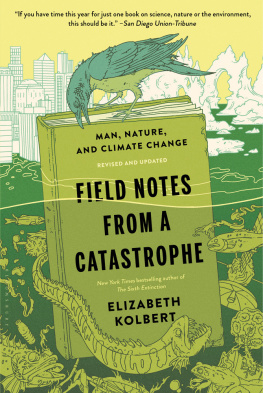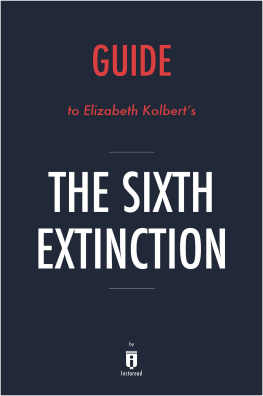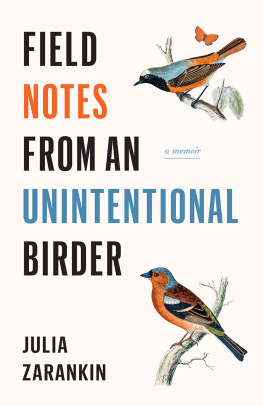Elizabeth Kolbert - Field Notes from a Catastrophe (rev. ed.)
Here you can read online Elizabeth Kolbert - Field Notes from a Catastrophe (rev. ed.) full text of the book (entire story) in english for free. Download pdf and epub, get meaning, cover and reviews about this ebook. year: 2014, publisher: Bloomsbury, genre: Art. Description of the work, (preface) as well as reviews are available. Best literature library LitArk.com created for fans of good reading and offers a wide selection of genres:
Romance novel
Science fiction
Adventure
Detective
Science
History
Home and family
Prose
Art
Politics
Computer
Non-fiction
Religion
Business
Children
Humor
Choose a favorite category and find really read worthwhile books. Enjoy immersion in the world of imagination, feel the emotions of the characters or learn something new for yourself, make an fascinating discovery.
- Book:Field Notes from a Catastrophe (rev. ed.)
- Author:
- Publisher:Bloomsbury
- Genre:
- Year:2014
- Rating:4 / 5
- Favourites:Add to favourites
- Your mark:
- 80
- 1
- 2
- 3
- 4
- 5
Field Notes from a Catastrophe (rev. ed.): summary, description and annotation
We offer to read an annotation, description, summary or preface (depends on what the author of the book "Field Notes from a Catastrophe (rev. ed.)" wrote himself). If you haven't found the necessary information about the book — write in the comments, we will try to find it.
Field Notes from a Catastrophe (rev. ed.) — read online for free the complete book (whole text) full work
Below is the text of the book, divided by pages. System saving the place of the last page read, allows you to conveniently read the book "Field Notes from a Catastrophe (rev. ed.)" online for free, without having to search again every time where you left off. Put a bookmark, and you can go to the page where you finished reading at any time.
Font size:
Interval:
Bookmark:
Many very busy people gave generously of their time and their expertise to make this book possible. A number of them have been named in the preceding pages, but a number have not.
Id like to thank Tony Weyiouanna, Vladimir Romanovsky, Glenn Juday, Larry Hinzman, Terry Chapin, Donald Perovich, Jacqueline Richter-Menge, John Weatherly, Gunter Weller, Deborah Williams, Konrad Steffen, Russell Huff, Nicolas Cullen, Jay Zwally, Oddur Sigurdsson, and Robert Correll for the help they provided on the chapters concerning the Arctic.
Similarly, I am indebted to Chris Thomas, Jane Hill, William Bradshaw, and Christina Holzapfel for their explication of evolutionary biology; to James Hansen, David Rind, Gavin Schmidt, and Drew Shindell for their lessons in climate modeling; and to Harvey Weiss and Peter deMenocal for sharing their work on ancient civilizations. Pieter van Geel, Pier Vellinga, Wim van der Weegen, Chris Zevenbergen, Dick van Gooswilligen, Jos Hermsen, Hendrik Dek, and Eelke Turkstra were extremely gracious to me when I visited the Netherlands. Robert Socolow, Stephen Pacala, Marty Hoffert, David Hawkins, Barbara Finamore, and Jingjing Qian spent many hours with me discussing mitigation strategies, while Senator John McCain, former vice president Al Gore, Annie Petsonk, James Mahoney, and Under Secretary of State Paula Dobriansky helped me to understand the politics of global warming. Mayor Pete Clavelle kindly showed me around Burlington. Michael Oppenheimer, Richard Alley, Daniel Schrag, and Andrew Weaver were always willingand ableto answer one last question.
This book began as a series of pieces that appeared in the New Yorker . I am deeply grateful to David Remnick for urgingindeed compellingme to write those pieces. I also want to thank Dorothy Wickenden and John Bennet who offered much valuable advice and encouragement along the way. I also want to thank Gillian Blake, Kathy Robbins, and Kathy Belden for all of their help, guidance, and good spirits.
The three chapters that I have added to this edition also began as stories in the New Yorker . Small bits of this edition also appeared in Audubon magazine and in my most recent book, The Sixth Extinction .
For their help with subjects ranging from ocean acidification to how to live on two thousand watts, Id like to thank Victoria Fabry, Ken Caldeira, Chris Langdon, Richard Feely, Chris Sabine, James Zachos, Ulf Riebesell, Joanie Kleypas, Sren Hermansen, and Roland Stulz.
Finally, I want to thank my husband, John Kleiner, who helped in more ways than he should have. Without his peculiar optimism, not a word here would have been written.
Authors Note
The language of science is metric; however, most British and American readers speakand thinkin units like feet, miles, and degrees Fahrenheit. I have used English units where practical and metric units where it seemed clearly more appropriate. For instance, the standard measure of carbon emissions is metric tons. A metric ton weighs 2,205 pounds.
Elizabeth Kolbert is a staff writer for the New Yorker . She is a two-time National Magazine Award winner and has also received a Heinz Award and a Guggenheim Fellowship. Kolbert lives in Williamstown, Massachusetts, with her husband and three sons.
The Alaskan village of Shishmaref sits on an island known as Sarichef, five miles off the coast of the Seward Peninsula. Sarichef is a small islandno more than a quarter of a mile across and two and a half miles longand Shishmaref is basically the only thing on it. To the north is the Chukchi Sea, and in every other direction lies the Bering Land Bridge National Preserve, which probably ranks as one of the least visited national parks in the country. During the last ice age, the land bridgeexposed by a drop in sea levels of more than three hundred feetgrew to be nearly a thousand miles wide. The preserve occupies that part of it which, after more than ten thousand years of warmth, still remains above water.
Shishmaref (population 591) is an Inupiat village, and it has been inhabited, at least on a seasonal basis, for several centuries. As in many native villages in Alaska, life there combinesoften disconcertinglythe very ancient and the totally modern. Almost everyone in Shishmaref still lives off subsistence hunting, primarily for bearded seals but also for walrus, moose, rabbits, and migrating birds. When I visited the village one day in April, the spring thaw was under way, and the seal-hunting season was about to begin. (Wandering around, I almost tripped over the remnants of the previous years catch emerging from storage under the snow.) At noon, the villages transportation planner, Tony Weyiouanna, invited me to his house for lunch. In the living room, an enormous television set tuned to the local public-access station was playing a rock soundtrack. Messages like Happy Birthday to the following elders... kept scrolling across the screen.
Traditionally, the men in Shishmaref hunted for seals by driving out over the sea ice with dogsleds or, more recently, on snowmobiles. After they hauled the seals back to the village, the women would skin and cure them, a process that takes several weeks. In the early 1990s, the hunters began to notice that the sea ice was changing. (Although the claim that the Eskimos have hundreds of words for snow is an exaggeration, the Inupiat make distinctions among many different types of ice, including sikuliaq , young ice, sarri , pack ice, and tuvaq , landlocked ice.) The ice was starting to form later in the fall, and also to break up earlier in the spring. Once, it had been possible to drive out twenty miles; now, by the time the seals arrived, the ice was mushy half that distance from shore. Weyiouanna described it as having the consistency of a slush puppy. When you encounter it, he said, your hair starts sticking up. Your eyes are wide open. You cant even blink. It became too dangerous to hunt using snowmobiles, and the men switched to boats.
Soon, the changes in the sea ice brought other problems. At its highest point, Shishmaref is only twenty-two feet above sea level, and the houses, most of which were built by the U.S. government, are small, boxy, and not particularly sturdy-looking. When the Chukchi Sea froze early, the layer of ice protected the village, the way a tarp prevents a swimming pool from getting roiled by the wind. When the sea started to freeze later, Shishmaref became more vulnerable to storm surges. A storm in October 1997 scoured away a hundred-and-twenty-five-foot-wide strip from the towns northern edge; several houses were destroyed, and more than a dozen had to be relocated. During another storm, in October 2001, the village was threatened by twelve-foot waves. In the summer of 2002, residents of Shishmaref voted, a hundred and sixty-one to twenty, to move the entire village to the mainland. In 2004, the U.S. Army Corps of Engineers completed a survey of possible sites. Most of the spots that are being considered for a new village are in areas nearly as remote as Sarichef, with no roads or nearby cities or even settlements. It is estimated that a full relocation would cost the U.S. government $180 million.
People I spoke to in Shishmaref expressed divided emotions about the proposed move. Some worried that, by leaving the tiny island, they would give up their connection to the sea and become lost. It makes me feel lonely, one woman said. Others seemed excited by the prospect of gaining certain conveniences, like running water, that Shishmaref lacks. Everyone seemed to agree, though, that the villages situation, already dire, was only going to get worse.
Morris Kiyutelluk, who is sixty-five, has lived in Shishmaref almost all his life. (His last name, he told me, means without a wooden spoon.) I spoke to him while I was hanging around the basement of the village church, which also serves as the unofficial headquarters for a group called the Shishmaref Erosion and Relocation Coalition. The first time I heard about global warming, I thought, I dont believe those Japanese, Kiyutelluk told me. Well, they had some good scientists, and its become true.
Next pageFont size:
Interval:
Bookmark:
Similar books «Field Notes from a Catastrophe (rev. ed.)»
Look at similar books to Field Notes from a Catastrophe (rev. ed.). We have selected literature similar in name and meaning in the hope of providing readers with more options to find new, interesting, not yet read works.
Discussion, reviews of the book Field Notes from a Catastrophe (rev. ed.) and just readers' own opinions. Leave your comments, write what you think about the work, its meaning or the main characters. Specify what exactly you liked and what you didn't like, and why you think so.











